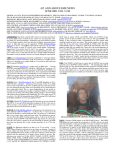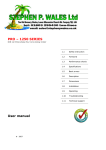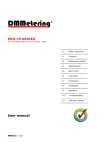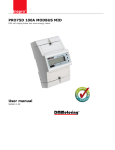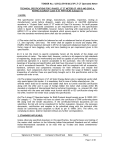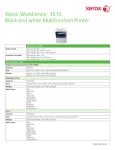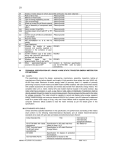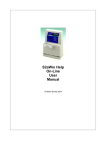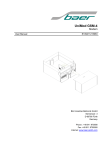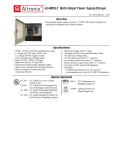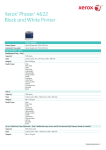Download USER`S MANUAL - Pal Mohan Group
Transcript
DDS67 SINGLE PHASE STATIC kWh METER USER’S MANUAL SHENZHEN KAIFA TECHNOLOGY CO., LTD. CONTENT I. Introduction …………………………………………………………………….. 1 II. Parameters ……………………………………………………………………… 1 III. Main Functions …………………………………………………………………. 1 IV. Display …………………………………………………………………………... 2 V. Installation ……………………………………………………………………… 4 VI. Transportation & Storage ……………………………………………………... 4 VII.Weight & Size ……………………………………………………………... … … 4 VIII. 4 Drawing……………………………………………………………………… USER’S MANUAL I. INTRODUCTION DDS67 single phase static kWh meter adopts advanced MCU, electrical power measurement technologies and perfect anti-tamper design. It is used to measure the active energy consumption of single phase two-wire electricity network of 50Hz alternating current and it can be set up to 6 tariffs. Its anti-tamper features can ensure the meter work properly under the following conditions: Interchanging of I/C & O/G; phase & neutral wires, etc. It has optical port and RS232 port to communicating with AMR modems/devices. All the functions of meter comply with technical standard of IS:13779-1999, IEC 61036 and CBIP No.88. II. PARAMETERS Reference voltage: 240V Limited operating voltage: 144V 440V Current: 10(60) A Frequency: 50Hz±5 Pulse constant: 1600imp/kWh Accuracy of RTC: 1 s/d Error limit of time setting: ±30s Power consumption of voltage circuit: ≤1W/ 4VA Power consumption of current circuit: ≤2VA Operating temperature range: -10 ~ +60 Limit operating temperature range: -10 ~ +70 Storage and transport temperature range: -25 ~ +70 Maximum relative humidity: 95% III. MAIN FUNCTIONS 1. Multi-tariff function The meter can set up to 6 tariffs and 6-time segment: T1, T2, T3, T4, T5, T6. The minimum unit of time segment is minute. The meter can store accumulative active energy of each tariff. 2. Energy measurement The meter measures active energy consumption for single phase power system. Previous six months active energy and time thereof are stored in the meter. The meter has non-volatile memory (NVM) that can retain important data up to 10 years in case of power failure. 3. Maximum demand The meter calculates Demand for an integration time of 30 minutes and records MD, date and time thereof. Previous six months’ MD is stored in NVM with occurring date and time. Push the MD-RESET button, the MD of current month will be set to zero. The data of MD and the data of previous six months’ MD stored in NVM can be read by meter-reading instrument. Clock and calendar: The minimum unit of energy measurement is second. The calendar is up to 100 years. Date & time can be set by meter-reading instrument. 4. Viewing data Consumers can push the button to view the data of meter at any time. The functions of LCD must be checked before pushing the button. The data will auto scroll in LCD and customers can also using meter-reading instrument to read data via optical port or RS232 port. Communication of RS232 port of the meter is designed to be powered by CMRI or RS232 port of computer, no additional power supply is needed. 5. Meter-reading & Program The meter can be read or set by CMRI. Code must be entered before program the meter. Regarding to the specification, please refer to “User’s Manual of CMRI”. Optical communication complies with IEC1107, mode C. 6. Pulse output for calibration LED in the meter cover can produce pulses for calibrate the meter. 7. Anti-tamper a. Interchanging of I/C & O/G Meter can record forward energy. b. Interchanging of phase and neutral wires Meter can record forward energy. c. Disconnected neutral wires of output and connect load to earth Meter can record forward energy. d. Put interferential signals to output The influence quantities comply with CBIP No.88. e. Disconnected voltage of input and connect load to L line and earth Meter can record forward energy. IV. DISPLAY S.No 0* 1 2 3 4 5 6 7 8 9 10 11 12 13 14 15 16 17 18 19 20 21 22 23 24 25 26 27 28 Code E0 P d0 T0 T d E1 E2 E3 E4 E5 E6 P1 d1 T1 P2 d2 T2 P3 d3 T3 P4 d4 T4 P5 d5 T5 P6 d6 Explaination Cumulative Active Energy MD of current month MD occurring date MD occurring time Time Date Cumulative Active Energy of previous month 1 Cumulative Active Energy of previous month 2 Cumulative Active Energy of previous month 3 Cumulative Active Energy of previous month 4 Cumulative Active Energy of previous month 5 Cumulative Active Energy of previous month 6 MD of previous month 1 Month 1 MD occurring date Month 1 MD occurring time MD of previous month 2 Month 2 MD occurring date Month 2 MD occurring time MD of previous month3 Month 3 MD occurring date Month 3 MD occurring time MD of previous month 4 Month 4 MD occurring date Month 4 MD occurring time MD of previous month 5 Month 5 MD occurring date Month 5 MD occurring time MD of previous month 6 Month 6 MD occurring date Can be Programed? NO NO NO NO YES YES NO NO NO NO NO NO NO NO NO NO NO NO NO NO NO NO NO NO NO NO NO NO NO 29 30 31 32 33 34 35 36 37 38 39 40 41 42 43 44 45 46 47 48 49 50 51 52 53 54 55 56 57 58 59 60 T6 E7 E8 E9 EA Eb EC P7 d7 T7 P8 d8 T8 P9 d9 T9 PA dA TA Pb db Tb PC dC TC F0 F1 F2 F3 F4 F5 88 Month 6 MD occurring time Active Energy of tariff 1 Active Energy of tariff 2 Active Energy of tariff 3 Active Energy of tariff 4 Active Energy of tariff 5 Active Energy of tariff 6 MD of current month of tariff 1 MD of current month of tariff 1 occurring date MD of current month of tariff 1 occurring time MD of current month of tariff 2 MD of current month of tariff 2 occurring date MD of current month of tariff 2 occurring time MD of current month of tariff 3 MD of current month of tariff 3 occurring date MD of current month of tariff 3 occurring time MD of current month of tariff 4 MD of current month of tariff 4 occurring date MD of current month of tariff 4 occurring time MD of current month of tariff 5 MD of current month of tariff 5 occurring date MD of current month of tariff 5 occurring time MD of current month of tariff 6 MD of current month of tariff 6 occurring date MD of current month of tariff 6 occurring time Tariff and time-sequence 1 Tariff and time-sequence 2 Tariff and time-sequence 3 Tariff and time-sequence 4 Tariff and time-sequence 5 Tariff and time-sequence 6 LCD test Note: The data with * will display continued. 1. Format of data and time is: Active Energy: XXXXXX KWH MD: XX.XX KW MD occurring date: MM:DD ( Month : Date ) MD occurring time: HH:MM ( Hour : Minute) Date: DD:MM:YY ( Date : Month : Year ) Time: HH:MM:SS ( Hour : Minute : Second ) 2. Format of data of tariff and time-sequence ( Current data set is 134501 ) NO NO NO NO NO NO NO NO NO NO NO NO NO NO NO NO NO NO NO NO NO NO NO NO NO YES YES YES YES YES YES NO 13:45:01 01: T1 tariff 1 02: T2 tariff 2 03: T3 tariff 3 04: T4 tariff 4 05: T5 tariff 5 06: T6 tariff 6 Tariff start time (hour:minute) V. INSTALLATION The meter to be installed and used must be tested and sealed before delivery. The multi-tariff meter must be installed in dry and ventilated environment. The installation board must be fixed on steady, fire-resistant and non-vibrant wall. The referential installation height is 1.8m. The method of how to install the meter is shown on meter terminal cover. VI. TRANSPORTATION AND STORAGE The meter should be placed on shelf and not exceed five box layers in transporting. The place for storage must be kept clean. This product should be stored in a warehouse which is clean and where the ambient temperature is -25 +70 , relative humidity is less than 90% and no erosive gas in air. VII. WEIGHT & SIZE The weight of meter is 1.2kg. The size of configuration of meter is 154.5mm×120mm×79mm. VIII. DRAWING 1. Configuration Drawing LCD Display Load connect to earth Energy pulse output Setting switch Neutral cut Current reverse Optical port View information switch 2. Wiring Diagram RS232 Li ne TXD COM RS232 Li ne RXD +8V L L








